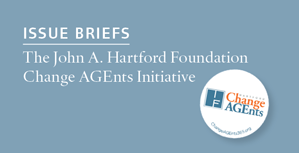 This is the second in a series of seven issue briefs.
This is the second in a series of seven issue briefs.Editor’s Note: Elder mistreatment is a serious and potentially fatal syndrome that has begun to get much-needed attention from the federal and private sectors. To continue building momentum and action toward eliminating elder mistreatment and making elder justice a reality, The John A. Hartford Foundation recently hosted two important convenings.
Just this month, on Feb. 12, the Foundation brought together elder justice thought leaders representing care delivery, policy, research, and philanthropy. The group discussed the state of practice in elder abuse assessment and intervention, and identified opportunities to accelerate the spread of evidence-based initiatives.
That convening was a perfect complement to a meeting of more than 100 John A. Hartford Foundation Change AGEnts that took place in December 2015, which included a group focused on elder justice. This group generated the following issue brief, the second in a series from the meeting that will be published on Health AGEnda over the following weeks.
Both convenings will help The John A. Hartford Foundation plan a course of action that builds on the strengths of existing efforts and funded programs. We are hopeful that we can all work together to end the scourge of elder mistreatment and ensure that elder justice prevails.
Elder Justice
Evidence suggests that at least 2 million older adults (one in 10 people over the age of 60) is abused or mistreated each year. This disturbing statistic, unfortunately, likely underestimates the real number significantly, as elder abuse is chronically under-identified or reported. The Elder Justice Issue Group at the John A. Hartford Foundation Change AGEnts Conference dug into the topic, identifying many of the challenges facing the field. The group, however, also suggested several ways to build momentum following the 2015 White House Conference on Aging’s focus on elder justice this past summer and a National Institutes of Health state-of-the-art workshop on the issue in the fall.
 Challenges
Challenges
A significant focus of the conversation revolved around Adult Protective Services (APS) systems across the country, where cases of elder mistreatment are generally referred. Better and more extensive screening is certainly needed, but there was recognition that these agencies are under-resourced and that APS workers are currently underpaid, undertrained, and overworked. In the community, older adults and the people who care for them are too often unaware of the issue and certainly don’t understand that abuse takes many forms and can involve overlapping health, mental health, domestic violence, substance abuse, financial, and legal issues.
The need to build capacity, build the field. Several areas of significant challenges around this issue were raised. Key areas of need included:
- Expanding and enhancing the workforce. This includes supporting more APS workers, as well as community-based, home-visiting mental health workers who can address the underlying causes of elder abuse, including substance abuse and other mental illness issues. In addition, APS workers need both additional training to equip them with health-related knowledge, as well as a career ladder that encourages advancement and long-term commitment to the work. A core set of national practice standards will be critical to this capacity building as well.
- More effective identification, screening, and referrals. Many APS agencies are stretched thin and may not be able to intervene on all positive screens for elder abuse and neglect. Even negative screens may identify serious health or other issues and may warrant follow-up. Depending on the nature of the complaint, APS could build its service capacity through referrals, as appropriate, to licensed social workers or similar community resources. Elder abuse hotlines, such as the state-funded hotline in Massachusetts, as well as work with primary care practices and emergency departments, can also provide helpful ways of expanding identification of elder mistreatment, again assuming appropriate APS or other referrals are available and supported.
- Broader partnerships are required. Outside of APS, providing elder abuse training for law enforcement, first responders, and other professionals in regular contact with older adults can broaden awareness about the issue and increase early identification of elder mistreatment. Several states already have Working Interdisciplinary Network of Guardianship Stakeholders (WINGS) programs. These are seeking to reform state guardianship systems and establish best practices so guardianship can be a safe option in the fight against elder exploitation.
- Gaps in knowledge and interventions. The gaps in knowledge about elder abuse make creating an organized, comprehensive approach to prevention and intervention more challenging. That said, APS staff often develop creative, albeit idiosyncratic, approaches to ensuring individual client’s needs are addressed. These innovative approaches, particularly those that involve partnerships with other community referral resources, should be documented and—where possible—formed into replicable models that apply across the range of APS case types. There is a role, particularly for academic leaders (like many John A. Hartford Foundation Change AGEnts), to develop these approaches and build the literature about which APS interventions work in which settings.
 Opportunities
Opportunities
Thinking toward solutions. While the group recognized the scope and challenges before the elder justice field, it had several concrete ideas about how to move the work forward:
- Advocate for Elder Justice Act funding. Passed in 2010, the Act, if fully funded, would provide a powerful boost to the field. Large-scale advocacy efforts are needed to move this ahead.
- Increase public concern. While building the capacity of APS systems is critical, expanding awareness among older adults, families and the general public is also important. Information and social media campaigns can help draw attention to the problem and help more people, including health care and aging services providers, recognize elder abuse when they see it.
- Learn from other analogous fields. Domestic violence, child protective services, and animal protection have all been successful in changing public opinion and creating cultural norms and policies that do not countenance violence and other forms of abuse. There may also be important insights to gain on how to address stigma and the fear of retaliation. The elder justice movement can learn from these examples about how to best build public will in support of its goals.
- Standardize APS services. While APS agencies require a range of capacity-building support, ensuring that all systems offer a common set of services will ensure more consistent responses and enable states and localities to maintain and grow infrastructure in more predictable ways.
- Support the National Center on Elder Abuse’s Innovative Practices Database, a helpful online tool from the Administration for Community Living, which can help to locate program models and information resources around the country related to prevention, intervention, and public education. Driving attention to this site and encouraging Change AGEnts and others in the field to contribute to its database could help build needed knowledge and capacity.
- Fund and disseminate effective models. Providing support for existing pilot programs or partnering with the ACL or CMS Innovation Center for new demonstration projects can take the innovation that is developing in the field and build approaches that can be disseminated and used broadly.
- Create an elder justice navigator or community ombudsman. This would allow easier reporting of elder mistreatment and importantly refer cases that don’t meet APS requirements to appropriate community resources.
Elder Justice Issue Group Participants
Robyn Golden, LCSW (Senior Respondent)
Rush University Medical Center
Daniel B. Kaplan, PhD LICSW (Facilitator)
Adelphi University,
School of Social Work
Jack Croft (Notetaker)
SCP
Terry Fulmer, PhD, RN, FAAN
The John A. Hartford Foundation
Caroline Gelman, MSW, LCSW, PhD
Silberman School of Social Work,
Hunter College
Joan Hatem-Roy, MSW, LICSW
Elder Services of Merrimack Valley, Inc
Teri Kennedy, PhD, MSW, LCSW, ACSW
Arizona State University,
School of Social Work
Philip Marshall, MS
Roger Williams University
Nora Obrien-Suric, PhD
The John A. Hartford Foundation
Tim Platts-Mills, MD, MSc
University of North Carolina at Chapel Hill
Read the first post in The John A. Hartford Foundation Change AGEnts Issue Briefs series:
